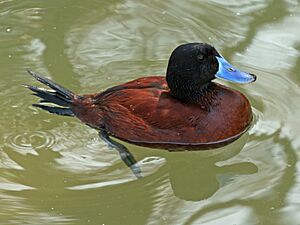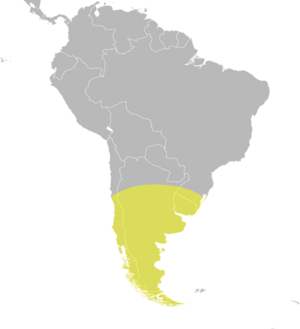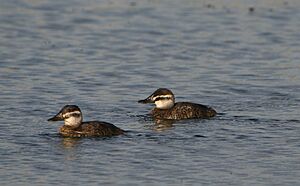Lake duck facts for kids
Quick facts for kids Lake duck |
|
|---|---|
 |
|
| Conservation status | |
| Scientific classification | |
| Genus: |
Oxyura
|
| Species: |
vittata
|
 |
|
| Oxyura vittata range | |
| Synonyms | |
|
Erismatura vittata (Philippi, 1860) |
|
The lake duck (Oxyura vittata) is a small duck that lives in South America. It's a type of stiff-tailed duck, which means it has a stiff tail that often sticks up. People also call it the Argentine blue-bill or Argentine ruddy duck.
Contents
What Does the Lake Duck Look Like?
Lake ducks are not very big. They usually grow to be about 36 to 46 centimeters (14 to 18 inches) long. That's roughly the length of a school ruler!
Female lake ducks weigh between 510 and 700 grams (about 1.1 to 1.5 pounds). Males are a bit heavier, weighing from 600 to 850 grams (about 1.3 to 1.9 pounds).
It can be a bit tricky to tell lake ducks apart from a similar bird called the Andean duck. However, male lake ducks are usually smaller and have a flatter head shape.
Lake Duck Behavior and Diet
Scientists don't know a lot about what lake ducks eat. But they believe these ducks mostly munch on tiny water creatures called invertebrates. They also eat seeds and bits of plants found in the water.
Reproduction and Breeding
The time when lake ducks have their babies changes depending on the country they live in. For example, in Argentina, their breeding season is from October to January.
When it's time to find a mate, male lake ducks make special sounds. They create popping noises and "mechanical rustling noises" to show off and attract females.
Where Do Lake Ducks Live?
The lake duck is a bird that sometimes migrates. This means they move from one place to another during different seasons.
They love to live in freshwater places that have lots of plants. You can find them in wetlands, lakes, and other watery areas.
Lake Duck Distribution
Lake ducks are found in many parts of South America. They naturally live in countries like Argentina, Brazil, Chile, Paraguay, and Uruguay. They have also been introduced to the Falkland Islands, which means people brought them there.
Conservation Status
The number of lake ducks in the world is quite stable. There are an estimated 6,700 to 67,000 of them. This species doesn't face many big threats right now.
Because of their healthy population, the lake duck is listed as a species of "least concern" on the IUCN Red List. This means they are not currently in danger of disappearing.



